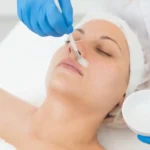THE WHAT? The Estee Lauder Companies has released its Green Score methodology to assess and measure the sustainability of ingredients and formulas based on green chemistry principles.
THE DETAILS The US prestige beauty giant has published a peer-reviewed manuscript, named Applying Green Chemistry to Raw Material Selection and Product Formulation at The Estee Lauder Companies, in The Royal Society of Chemistry’s Green Chemistry journal. The article shares Lauder’s methodology, data sources and unique framework to quantitively evaluate ingredients and formulas across its in-house portfolio of beauty products.
THE WHY? George Daher, Senior Vice President, Product Safety, Regulatory Affairs and Green Chemistry, The Estée Lauder Companies, explains, “At The Estée Lauder Companies, we are committed to creating breakthrough, high-performing products that embed sustainability throughout their lifecycle. Our Green Score measurement and assessment tool enables us to integrate green chemistry into our product development process and further enhance the sustainability of our products. We hope that by publishing this methodology, our approach can be adopted, built upon and scaled by others across our industry to further advance sustainability and transparency.”
Aesthetic medicine products are developed and regulated to meet stringent safety and efficacy standards. They are typically administered by trained healthcare professionals such as dermatologists, plastic surgeons, and specialized nurses in clinical settings. These products aim to provide effective solutions for cosmetic enhancement, skin rejuvenation, and overall aesthetic improvement, contributing to both physical appearance and self-confidence.
Key categories of aesthetic medicine products include:
-
Injectables: This category includes products such as dermal fillers, botulinum toxins (e.g., Botox), and collagen stimulators. These injectables are used to smooth wrinkles, add volume, and improve facial contours.
-
Skin Rejuvenation Treatments: Products like chemical peels, microdermabrasion systems, and laser devices are used to improve skin texture, reduce pigmentation irregularities, and enhance overall skin tone.
-
Skincare Products: These include medical-grade cleansers, moisturizers, serums, and topical treatments containing active ingredients like retinoids, antioxidants, and growth factors. They are formulated to address specific skin concerns such as acne, aging, and hyperpigmentation.
-
Hair Restoration Products: Medical treatments and products designed to promote hair growth and treat conditions such as male and female pattern baldness.
-
Body Contouring and Fat Reduction: Devices and products used for non-surgical body sculpting, such as cryolipolysis (cool sculpting) devices and injectable lipolytics.
-
Cosmeceuticals: High-performance skincare products that bridge the gap between cosmetics and pharmaceuticals, often containing potent ingredients with proven clinical benefits.
-
Wound Care and Scar Management: Products like silicone sheets, gels, and advanced wound dressings used to improve healing and reduce the appearance of scars.





